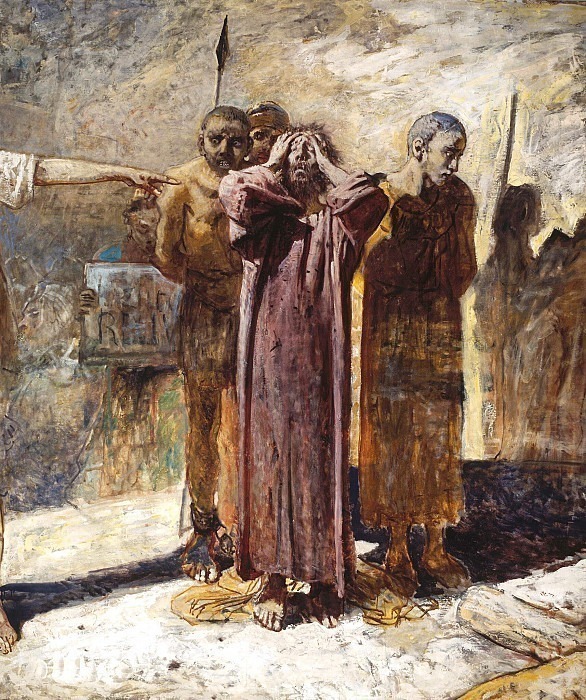Golgotha Nikolay Ge (1831-1894)
Nikolay Ge – Golgotha
Edit attribution
Download full size: 1714×2048 px (0,6 Mb)
Painter: Nikolay Ge
Location: The State Tretyakov Gallery, Moscow (Государственная Третьяковская галерея).
The painting "Golgotha," was one of the last works of Nikolai Ge and, according to critics, remained unfinished. The author tried to imbue his work with a deep moral sense. At the center of the painting is Christ and two robbers. Each personage has his own personality traits. Thus the author engages in a dialogue with the viewer, subtly hinting at the events and describing the mood of each of the characters.
Description of the painting "Golgotha" by Nikolai Ge
The painting "Golgotha," was one of the last works of Nikolai Ge and, according to critics, remained unfinished. The author tried to imbue his work with a deep moral sense.
At the center of the painting is Christ and two robbers. Each personage has his own personality traits. Thus the author engages in a dialogue with the viewer, subtly hinting at the events and describing the mood of each of the characters. The Son of God is overcome by despair, he wrings his hands. His eyes are closed and his head is involuntarily thrown back.
From behind Jesus, the culprit looks out with his hands tied. His mouth is ajar, and his eyes widen of their own accord in horror. On the right stands the young man, formerly a robber, now a martyr, who turns away sadly. One cannot help but notice how the author contrasts his characters. All the figures are motionless, as if frozen in anticipation of the inevitable.
On the left, an oppressive hand appears in sight, signaling the beginning of the execution. The figure of Jesus radiates hopelessness, he anticipates a long and painful death. A cross has already been placed at his feet. Nikolai Ge shows exactly how Christ was betrayed and sent to a shameful execution. The artist with all his being understood that the Son of God was unjustly executed. The task that the author set himself was to convey to the viewer that Christ, by his act, atoned for the sins of the entire human race and gave mankind a chance for salvation, sacrificing his life.
He was reproached for his neglect of form and his abuse of contrasting colors. Perhaps this was the only method capable of expressing the feelings of the artist.
Ge painted with characteristic broad strokes and was not afraid to use diametrically opposed colors in his paintings. He was encouraged by the idea with moral characteristics rather than religious overtones. So he depicted Christ as a symbol of self-denial, for the sake of saving people’s souls. Nikolai Ge all his life hoped that through art humanity would come to its senses and the world would be reformed.
Кому понравилось
Пожалуйста, подождите
На эту операцию может потребоваться несколько секунд.
Информация появится в новом окне,
если открытие новых окон не запрещено в настройках вашего браузера.
You need to login
Для работы с коллекциями – пожалуйста, войдите в аккаунт (open in new window).














COMMENTS: 1 Ответы
замечательная картрна Ге, композиция, краски, передающие настроение написанного, изображение, кажется, четырёх чувств: неосознание, гнев, отчаяние, смирение со смертью, последний смиренно смотрит на эту тень в виде копья
You cannot comment Why?
The backdrop is rendered in a rough, textured style, with muted ochre and brown tones suggesting a harsh, arid environment. Dramatic lighting casts strong shadows, further enhancing the emotional intensity of the scene. A stone slab with carved letters, possibly bearing the inscription INRI, is visible near the accuser, a subtle but significant reference to the crucifixion narrative.
The subtext of Golgotha is deeply rooted in Christian theology, specifically the Passion of Christ. The painting powerfully conveys themes of suffering, betrayal, judgment, and sacrifice. The stark depiction of the central figure’s anguish highlights the human suffering of Jesus during his crucifixion. The aggressive stance and pointed finger of the accuser symbolize the forces of condemnation and persecution. The subdued expressions of the other figures hint at the complex emotional landscape surrounding such an event – the fear of those involved in carrying out orders, and perhaps the sorrow of witnesses. The raw, emotional brushwork and stark lighting contribute to an atmosphere of profound tragedy and spiritual weight, inviting contemplation on themes of sin, redemption, and divine sacrifice.